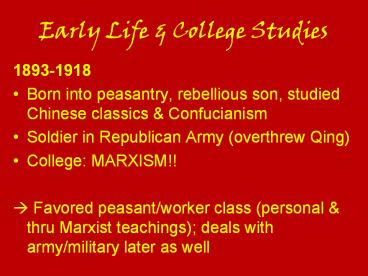Early Life - PowerPoint PPT Presentation
1 / 18
Title:
Early Life
Description:
... Improved on guerilla warfare KMT troops destroyed and Mao gained prestige Long March 1934 Chiang tried to eliminate ... death/ abandonment of girls, ... – PowerPoint PPT presentation
Number of Views:72
Avg rating:3.0/5.0
Title: Early Life
1
Early Life College Studies
- 1893-1918
- Born into peasantry, rebellious son, studied
Chinese classics Confucianism - Soldier in Republican Army (overthrew Qing)
- College MARXISM!!
- ? Favored peasant/worker class (personal thru
Marxist teachings) deals with army/military
later as well
2
Party Affiliation
- 1920-1927
- Failed at democratic organization
- Founded CCP branch in Hunan (communist)
- Joined KMT to help against invaders
- Organized peasant unions, got leadership roles
published power of peasants - ? Marxist ideas isolated him
3
Autumn Harvest Uprising Red Army Formation
- 1925-1929
- KMT Chiang Kai-shek battled communists Mao led
peasant armies he was defeated left for rural
area - ? Developed land reform ideas, recruited troops
- Troops became known as Red Army (contd into his
rule) Improved on guerilla warfare - ? KMT troops destroyed and Mao gained prestige
4
Long March
- 1934
- Chiang tried to eliminate
- communists again, Mao
- escaped began march to
- protected base (6000 miles)
- ? Zunyi Conference held along way where Mao
gained power (more leadership)
5
Japanese Invasion
- 1931-1937
- Imperial Japan moved further into China KMT
CCP temporarily united - Troops made mainly of peasant (Red Army)
- ? Success of peasant army solidified Maos
efforts, he moved up in rankbegan pushing out
his critics in CCP
6
Civil War
- 1945-1949
- Japan lost WWII KMT vs. CCP for control of China
- CCP had large, trained army and won in Oct.
1949declared Peoples Republic of China - ?China was in despair, Mao in power, modeled
reconstruction after USSR (socialist ideals)
7
Korean War Hundred Flowers Movement
- 1950-1953, 1957
- Mao relied on USSR aid, allied with N. Korea,
millions of Chinese died - ? Became enemies with US
- Mao wanted PRC to be united as oneled campaigns
to weed out traitors - HFM- encouraged criticism, but it was more than
expected, and attacked rightists - ? See evidence of fear in intellectuals later
8
Great Leap Forward
- (In 1949, land taken from landowners given to
peasants who worked it ?) - 1958-1960
- land taken from peasants turned into communes
owned by state ? - 20-40 families _at_ first ? county size (1,000s)
- Build backyard furnaces instead of factories to
make iron tools - Melt down scrap metalbut then ran out and
started melting already usable objects! (had to
meet quota) - Couldnt use what they melted (too brittle)
- These workers also were NOT making food
9
"Everybody is fully occupied in production, the
trade sector is also fully occupied for
everybody."
10
Great Leap Forward
- Commune leaders forced to meet quota of food
production - Couldnt meet it? lied about amount produced
- Govnt took based on that lie? peasants starved
- Some food taken by govnt rotted in warehouses
before being distributed, some sent to USSR for
loan payment - Told to do close planting to use land efficiently
- Plants use each others nutrients and they all
die! - (All critics were purged from office, many stayed
quiet b/c of HFM)
11
Great Leap Forward
- ? Over 20 million people died
- Not realized until outsiders came in, studied
demographics - People eventually turned to cannibalism
- 1961 Mao realized it didnt work? gave 3 men,
including Deng Xiaoping, 5 years for economic
recovery - 1966Mao didnt like they had control ? leads to
Cultural Revolution
12
Cultural Revolution
- 1966-1976
- Maos economic recovery task force had always
been loyal, but no longer agreed with his
ideologies - Mao saw same ?s in USSR ?? got grp. of radicals
together to purge them - Created Red Guard (students)
- Closed school to allow them to join
- ? Mass propaganda of devotion to Mao (more so
than Stalin), Little Red Book
13
(No Transcript)
14
Cultural Revolution
- Beat, tortured, and imprisoned leaders who
opposed him - Suppressed all disorder/opposition with violence
- Lin Biao designated as Maos successor
- Pushed Maos Little Red Book
- Instituted martial law
- ? Mao eventually disposed of him for having too
much power (fled to USSR)
15
Death Succession
- 1976
- 1972 Mao and his new successor both have health
problems? brings back Deng Xiaoping - Radicals continue to purge opposition
- 1974 Mao favors Deng b/c economy is so bad
- 1976 Mao dies
- His helpers (Gang of Four) are arrested
- Deng emerges as leader in 1977
16
One-Child Policy
- 1979
- Mao had encouraged large families (labor for
communes, soldiers)exponential population growth - Deng needed to cut growth dramatically
- Very severe punishments at first, less strict now
- ? Unbalanced gender ratio, death/ abandonment of
girls, controlled adoption policies, smaller
population growth
17
Tiananmen Square Massacre
- 1989 (June 4)
- In Peking (Beijing), civilian/ student protest
for democratic reform - Army came in shooting, with tankshundreds
(thousands?) killed - Happening simultaneously with protest in USSR
- ? Global condemnation
18
Timeline Questions
- Whos social and philosophical thought did Mao
begin following while in college? - What viewpoint of Maos led to him being rejected
by both the CCP KMT? - What was the positive turnout for Mao from the
Autumn Harvest Uprising? - Why did the U.S. become Maos enemy?
- What was the Hundred Flowers movement?
- What are some reasons the Great Leap Forward
failed?































